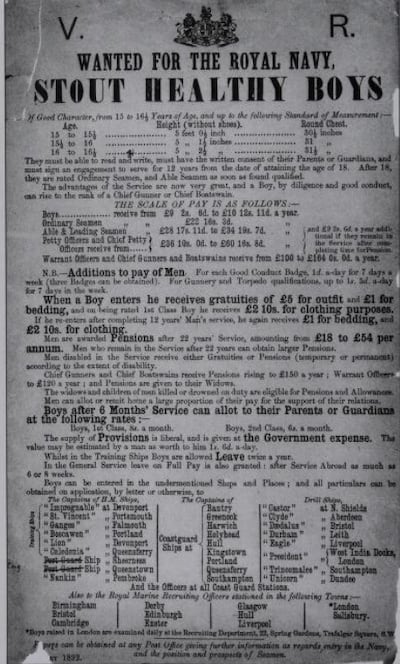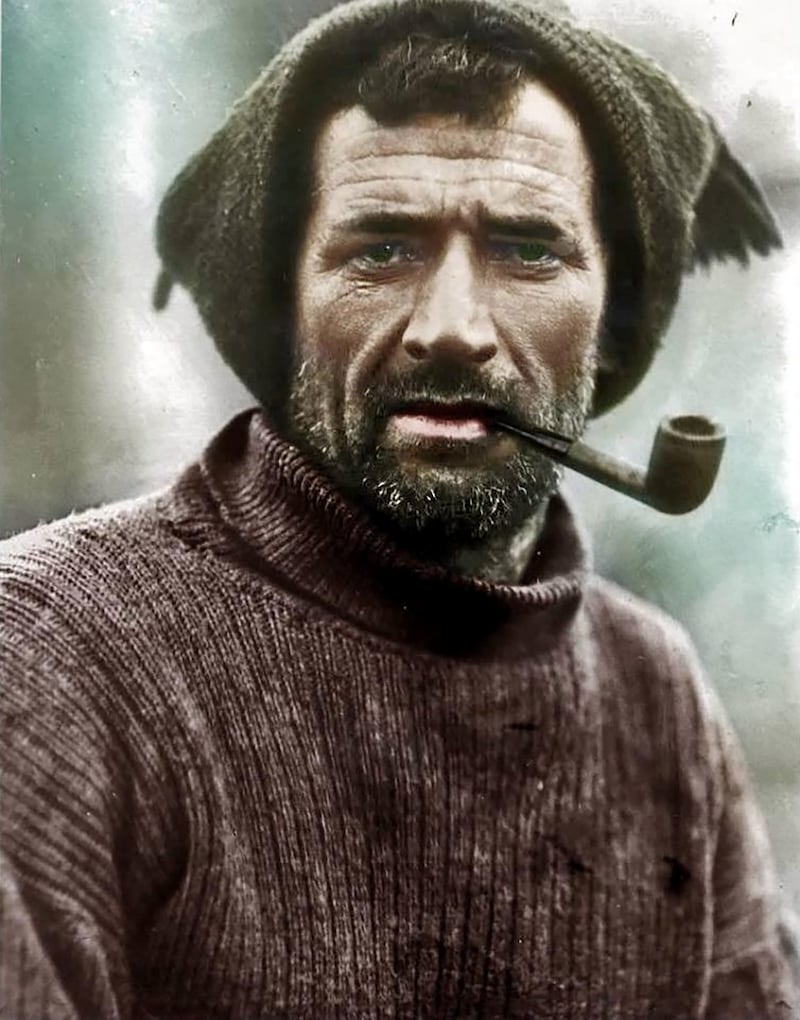It’s December 10th, 1901 and a 24-year-old sailor walks slowly up the dockside of Lyttelton Harbour in New Zealand to take up his next assignment aboard the ship RRS Discovery. With his kitbag over his shoulder, Tom Crean is unaware that he is about to enter a new phase of his life that will bring him the contentment for which he has long yearned. As he heads towards the gangway of the ship, he reflects on the past seven years and his time in the Victorian navy.
He remembers the recruitment poster that had been passed around Annascaul back in Kerry. How it promised so much to any boy willing to take the plunge and join the crews of the British navy. Aged 16 , Crean, enticed by what he had read – and with no prospect of a better life should he remain – signed up at the nearby coastguard station of Minard.
Born into poverty, the son of a tenant farmer, Crean anticipated further hardships but took comfort from the idea that friends who had made this same journey might be there to greet him when he began his training at Devonport on the south coast of England. He was in for a rude awakening. No such welcomes awaited him.
Assigned to the boys training ship HMS Impregnable, Crean would discover a harsh reality. The living quarters in the underbelly of the vessel were dark, damp and overcrowded. Worse was to follow when training began. The expectancy that boys ensure their kit, uniform and manners were up to the standards demanded by the Royal Navy was ruthlessly administered by military taskmasters. The punishment for trivial misdemeanours such as missing a button or having an untied bootlace was 12 swipes of the cane or, worse still, 24 lashings of the birch. The public spectacle, a regular slot in the daily schedule of young recruits, served as a deterrent to the audience of young lads made to witness it.
READ MORE
Just 17 months after joining the navy, Crean was deemed ready to venture out on his first seagoing assignment and in December 1894 he boarded HMS Wild Swan. The mission was to set off for the Pacific Station that safeguarded the interests of the British Empire along the west coast of the Americas, and the decision to send the wooden vessel, described as being “hopelessly obsolete”, was, according to naval commentators, “a scandalous waste of public money”.
The young farmer’s son faced a 10,000-mile voyage on a ship deemed “altogether out of date”. At the age of 17, Crean would have to endure the terrifying prospect of rounding Cape Horn, known as the “sailor’s graveyard” and the most hazardous shipping route in the world.

After almost three months at sea, the ship arrived at Valparaiso, Chile, where Crean was transferred to the flagship HMS Royal Arthur. Almost immediately, the flagship, accompanied by Wild Swan and HMS Satellite, headed to Corinto, Nicaragua, after receiving orders to blockade the port. Their mission was to collect a £15,000 indemnity from the Nicaraguans for their mistreatment of British subjects who had allegedly been ousted from their homes, arrested and confined in Managua, the Nicaraguan capital.
When a deadline for handover of the indemnity had passed, a detachment of 400 men from the naval force occupied the town without opposition. Martial Law was declared and it is likely that Crean was among their number. Fortunately, for a man who would later be renowned for saving lives, the stand-off ended peacefully after the money was handed over. Re-assigned to Wild Swan, Crean sailed north to the naval base of Esquimalt in Canada, home of the Pacific fleet.
Two of his aunts, Johanna and Margaret, had earlier emigrated and had settled on the east coast of America, but they were over 3,000 miles away from their nephew, so any thoughts of visiting them while on shore leave would be out of the question.
Over the following three years, Crean would repeatedly find himself thrust into international incidents in an era when rebellions and battles for territory were commonplace across the countries and islands in an area that stretched from the Arctic to the Antarctic Circles.
In Guayaquil, Ecuador, the crew witnessed many atrocities as battles were waged in the streets, where the “slaughter”, it was reported, was “horrendous”. More such ordeals were to follow, yet the ship’s duties also called for her to attend locations that today are considered tropical havens.
In the years before Crean forged his reputation on the coldest, most inhospitable place on Earth, he left his footprints in the sun-drenched climes of Hawaii, Tahiti and Acapulco.
In 1898, Wild Swan, with Crean aboard, returned to Plymouth, England, where for the next two years he would attend various shore-based training establishments in order to build up his arsenal of skills. It was a time that also allowed him periods of leave to return home to his family.
His fledgling years in the British navy had been a baptism of fire and, in February 1900, yet another long-distance assignment awaited as he boarded HMS Diana, bringing him and 450 fellow sailors to Sydney to man the ships of the Australian Station.

Among the first experiences aboard HMS Ringarooma, the ship to which he was assigned, was a 12-day period of quarantine in Nouméa, New Caledonia. The crew’s enforced isolation was a safety measure brought about to prevent any further outbreaks of the deadly bubonic plague which had caused 103 deaths after first being detected in Sydney during the early months of 1900. From Nouméa, Crean and his shipmates embarked upon a three-month tour of the New Hebrides (modern-day Vanuatu), an archipelago of more than 80 islands, located off the northeast coast of Australia.
[ Frank McNally on James Joyce and Ireland’s bubonic plague scare of 1900Opens in new window ]
In the land-grabbing days of empire, tensions were high between French and British ships sailing to the outlying islands around Australia, as each sought sovereignty of territory as yet unclaimed by either nation. The particular mission of Ringarooma over the course of the southern hemisphere’s winter period was described as a “punitive mission”. The aim was to subjugate warring tribes of the region.
The following report of a correspondence sent by an officer of Ringarooma during the mission does not detail how certain tribal customs impacted on the minds of crew members who encountered evidence of them. The mental wellbeing of such witnesses was, in the Victorian era, of little concern.
“Letters received by Ringarooma state that there has been a good deal of fighting on Tanna Island. Cannibalism was found to exist on many of the Islands, it is seen in its worst form on Aoba where the people seem really fond of human flesh.”
Unsurprisingly, it was reported that all crew-members were ecstatic when the mission ended. One officer was quoted as stating: “Sydney is a heaven, after three months in the Islands”.
Amid unrest aboard Ringarooma a month after her return in November 1900, three deserters, described as “stragglers”, became the first of a number to flee the ship. By December 1900, Crean had suffered his second demotion in what appeared to be a reflection of his own discontented mindset. Did he too contemplate desertion? Perhaps fleetingly, but Crean was a man of strong resolve and he stuck with his career in the Royal Navy.
In October 1901, Ringarooma sailed to New Zealand to relieve HMS Mildura. It was a journey that would determine the direction of Crean’s life and career.

Moored at the dockside was the Discovery, whose commander, Robert Falcon Scott, was about to make a fateful decision. Needing to replace a deserter, Scott recruited Crean, possibly on the recommendation of Discovery members whom the Irishman had previously served alongside, among them a stoker named William Lashly.
Twelve years later, Lashly would accompany Crean to Buckingham Palace as both men stepped forward to receive the Albert Medal for their bravery in the historic rescue of Edward Evans during the fateful Terra Nova expedition.
Crean’s early years had taken him to many places of exquisite beauty, yet it had also opened his eyes to the ugliness of man’s inhumanity to man, much of it in the pursuit of land and power. No such human conflict would face Crean in the uninhabited world that awaited him.
Tom Crean: The Extraordinary Life of an Irish Hero by Tim Foley is published by Merrion Press

















